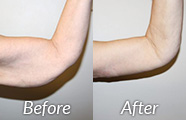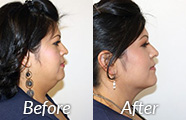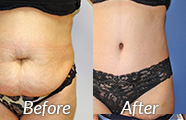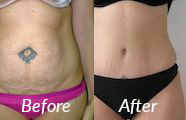Umbilical Hernia Repair
Conveniently located to serve the areas of Santa Monica, Beverly Hills and Greater Los Angeles
Umbilical hernia repair, or herniorrhaphy, is a surgical procedure that corrects a hernia by repairing the abdominal tissue. When the abdominal musculature is weakened or damaged, fatty tissue and/or part of the bowel can protrude outward from underneath the wall. Though they are commonly asymptomatic, umbilical hernias can require surgical intervention if they cause discomfort or distress. Plastic surgeons frequently repair this condition during a tummy tuck procedure.
Dr. Michael Zarrabi is a double-board-certified plastic surgeon who takes pride in performing comprehensive aesthetic and reconstructive procedures for his patients. He provides cosmetic procedures and treatments for patients all around Greater Los Angeles. His private practice, Zarrabi Plastic Surgery, has two locations in Santa Monica and Beverly Hills.
To schedule a consultation with Dr. Zarrabi today, please call (310) 584-9990 or fill out this contact form to take the first steps.
Contents
What is a Hernia?
An umbilical hernia is a common condition characterized by an abdominal wall defect that leads to the protrusion of abdominal contents through the umbilical ring. They occur because an increase in pressure weakens the ventral abdominal fascia. Patients who experience pregnancy, obesity, incorrect heavy lifting, or an injury may develop an umbilical hernia from increased pressure and shifting of the abdominal tissues. Women are three times more likely to develop an umbilical hernia due to the occurrence of childbirth and higher incidence of obesity. (1)
When the abdominal wall stretches due to these events, the muscles weaken and separate. This can cause a condition called diastasis recti, which is commonly repaired during an abdominoplasty (tummy tuck). (2) Both diastasis recti and umbilical hernias are associated with the separation of abdominal musculature and a weakened core. Many patients experience little or no discomfort from an umbilical hernia, but they do not disappear on their own. Dr. Zarrabi can intervene to secure the misplaced tissue and repair the abdominal wall. This procedure not only corrects the protruding tissues. It also smooths the abdomen and reinforces your core for a more trim body contour.
Benefits of Umbilical Hernia Repair
Umbilical hernia repair surgery benefits patients by improving the following:
- Overall Comfort: If a patient is experiencing discomfort from their hernia, surgery is the only way to completely remove it.
- Quality of Life: This procedure relieves pain and allows patients to get back to their regular weight-bearing activities and exercise.
- Complication Risk: Hernia repair greatly reduces the risk of complications like obstruction of the bowel or tissue strangulation that may happen if the hernia is left alone.
- Core Strength: Repairing the bulging tissue and the abdominal wall restores the patient’s core strength.
- Abdominal Contour: Correcting an umbilical hernia returns the midsection to its original and flush profile. When combined with an abdominoplasty, it can even further improve a patient’s contour.
- Risk of Future Hernias: Umbilical hernia repair surgery corrects the stretching and shifting abdominal wall to prevent future hernias from forming.
Ideal Candidates
Umbilical hernias often present as protrusions near the belly button, but not always. You may require a physical examination to find a hernia that is not visibly bulging. Ideal candidates for hernia repairs are in good overall health with no serious underlying medical conditions that may interfere with recovery. They may have experienced multiple pregnancies and significant weight loss, two situations that often lead to hernia development. They should be non-smokers or willing to quit tobacco and nicotine use for the required time before and after surgery.
Candidates for other cosmetic procedures like liposuction or a tummy tuck may also be suitable patients for umbilical hernia repair if they require it. Speak with Dr. Zarrabi about your options during your initial appointment.
Private Consultation at Zarrabi Plastic Surgery
Dr. Zarrabi will meet with you privately to discuss umbilical hernia repair and your candidacy. He will perform a comprehensive medical examination before planning your surgery. After choosing the appropriate surgical approach for your circumstances, he will create a customized procedure plan and provide you with before and after instructions. A member of the Zarrabi Plastic Surgery staff will then assist you with scheduling your hernia repair surgery after your appointment.
Preparation
To best prepare for umbilical hernia repair, patients should avoid NSAIDs like ibuprofen and aspirin as they thin their blood. For the same reason, please refrain from drinking alcohol in the weeks leading up to your procedure. Certain herbal supplements like fish oil and vitamin E should be avoided as well to prevent any negative interactions. Dr. Zarrabi explains the guidelines and other preoperative instructions at the initial consultation.
Umbilical Hernia Repair Surgery
Primary Hernia Repair
Correcting a small hernia (less than 2 cm in diameter) typically requires open primary repair surgery. Dr. Zarrabi places an incision near the hernia bulge by the belly button. This is usually shaped in a small crescent underneath the umbilicus. He then dissects the skin and subcutaneous tissue to get to the sac where he removes the excess fat or repositions the bowel to smooth the area. Dr. Zarrabi carefully sutures the abdominal wall back together to prevent a new hernia from developing. This surgery takes 30 to 45 minutes to complete. (3)
Herniorrhaphy with Mesh
Dr. Zarrabi may use a synthetic mesh to repair your umbilical hernia. During this surgery, he places his incision along the bottom of the belly button and navigates towards the hernia. Next, he sutures the mesh either above or below the fascia to restore the wall’s integrity. This becomes integrated within the body over time to provide support. Finally, he closes the external incision and bandages the sutures. Mesh hernia repairs can take anywhere from 30 minutes to 2 hours to complete depending on the severity of the hernia and its placement. (1)
Recovery & Results
Every patient’s recovery period is unique to their situation. Most hernia repair patients return to work after 2 to 3 days and reintegrate into their usual routine around the third week of recovery. Any discomfort can be remedied with pain medications prescribed by Dr. Zarrabi. He encourages you to take short and gentle walks to regulate blood flow until you return to your regular activities. Patients should not participate in any heavy lifting for 4 to 6 weeks after their hernia repair.
The results of an umbilical hernia repair are permanent and often noticeable immediately after surgery. After your hernia repair, the skin around the belly button will no longer bulge when you flex your abdominal wall. You will be more comfortable during exercise and daily activities. Your risk of hernia-related complications will decrease and you will feel better within your body. The contours of your abdomen will likely be smoother and no longer painful.
Complementary Procedures
Tummy Tuck
Dr. Zarrabi performs tummy tucks, or abdominoplasty, for patients with excess skin and fatty tissue on the lower abdomen. After pregnancy or weight loss, patients are often left with large amounts of skin and tissue that cannot be addressed with diet and exercise alone. Tummy tuck surgery safely removes extra, stretched skin and repositions the belly button to smooth the contour of a patient’s midsection. This surgery commonly includes liposuction to shape the flanks and improve the results.
For some patients, combining a tummy tuck and an umbilical hernia repair surgery may be beneficial. Especially after pregnancy, patients could have excess skin, diastasis recti, and a hernia, all of which can be repaired during this dual surgery. It saves patients time, energy, and money to receive multiple procedures at once under the expert care of Dr. Zarrabi. For those who have cosmetic concerns with other areas, he can also perform a mommy makeover to restore a pre-pregnancy body shape.
For more information about cosmetic surgery and Dr. Zarrabi, please read our blog.
Cost of Umbilical Hernia Repair in Greater Los Angeles
The total cost of an umbilical hernia repair is completely dependent upon the patient’s circumstances and their unique treatment plan. Small, simple hernia repairs may not require general anesthesia, making the procedure total much lower than a more complicated surgery.
Dr. Zarrabi explains the estimated total cost during your private consultation at Zarrabi Plastic Surgery. To schedule a meeting today, we encourage you to call (310) 584-9990 or complete our online form to get in touch. We hope to hear from you soon.
FAQ
Is umbilical hernia surgery painful?
During the procedure itself, patients are typically under general anesthesia or local anesthesia with sedation, ensuring comfort throughout the surgery. Following surgery, some discomfort is common but can be managed with prescribed pain medications.
Do I have to stay at the surgery center overnight after an umbilical hernia repair?
Not usually. This surgery is typically outpatient, allowing patients to return home after waking up from sedation or anesthesia.
What are the benefits of using mesh during hernia repairs?
For particularly severe hernias, mesh can provide a more durable repair and greatly reduces the risk of recurrence.
Will I have scars after an umbilical hernia repair?
You cannot completely avoid scarring after surgically repairing a hernia. Patients who undergo an open repair will have a small incision scar near the belly button that fades with time.
References
- Coste AH, Jaafar S, Parmely JD. Umbilical Hernia. PubMed. Published 2020. Accessed June 4, 2024. https://www.ncbi.nlm.nih.gov/books/NBK459312/
- Jessen ML, Öberg S, Rosenberg J. Treatment Options for Abdominal Rectus Diastasis. Frontiers in Surgery. 2019;6(65). doi:https://doi.org/10.3389/fsurg.2019.00065















